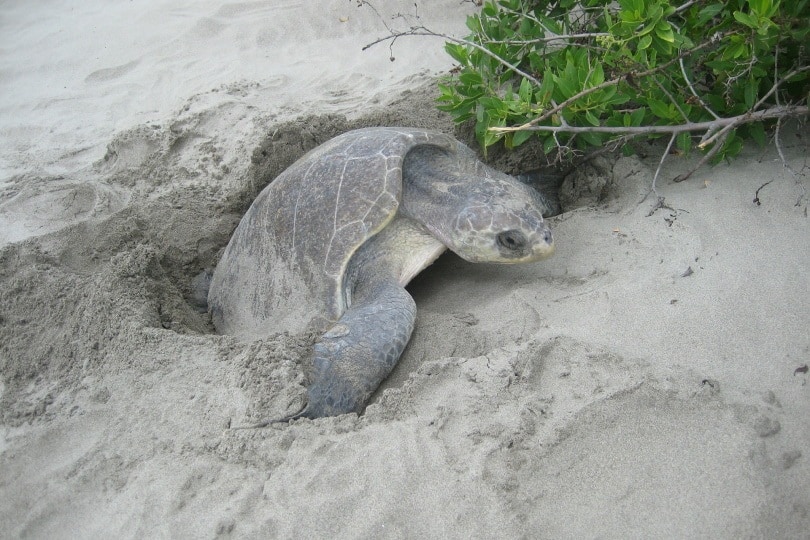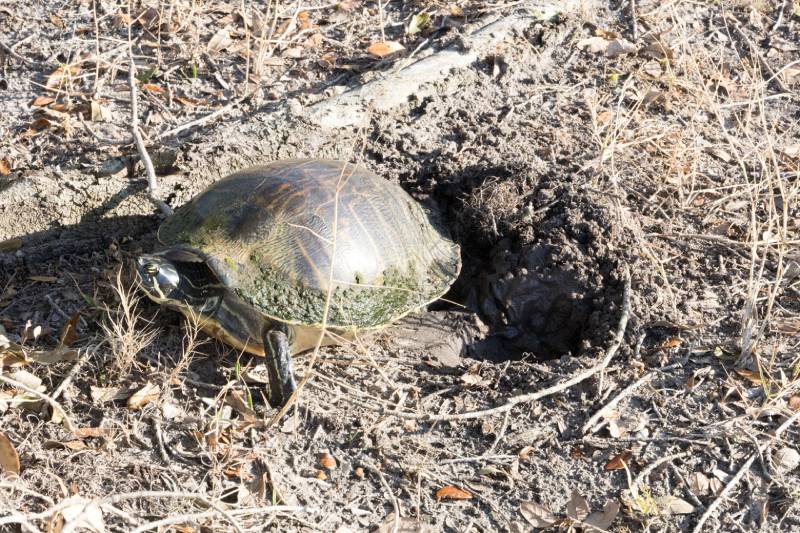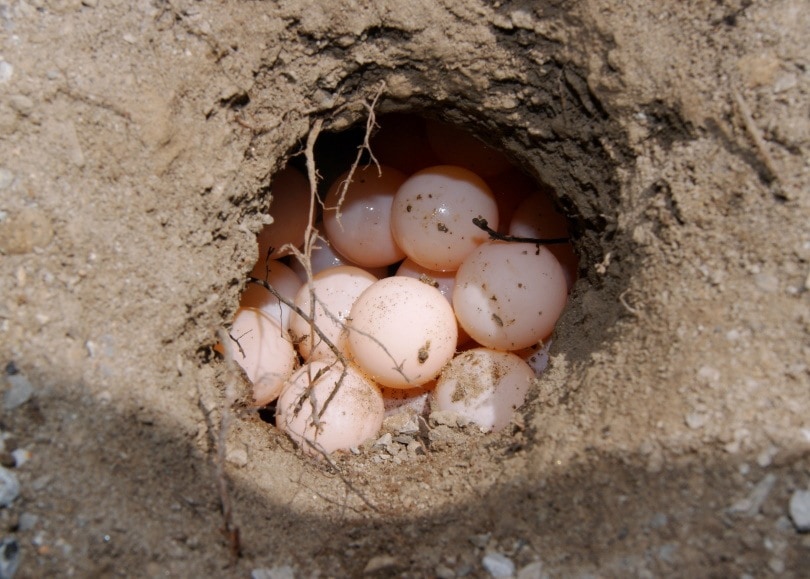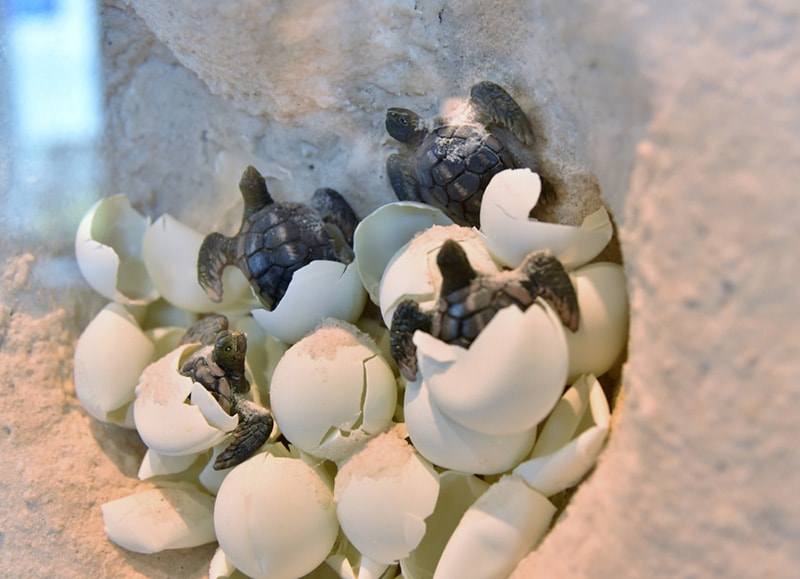
The class Testudines, also known as turtles, includes hundreds of species of turtles, tortoises, and terrapins that exist all over the world’s continents and oceans. Because of turtles’ wide range of species and habitats, their reproduction and life cycles vary widely.
What they all have in common is that all species of turtles are amniotes; like birds and other reptiles, they breathe air and lay their eggs on dry land, even if they live in or near water.
Turtle Reproduction
One thing that can be said about the many turtle species, is that their habits are all quite different. Turtle mating usually takes place where the turtle lives, ie. aquatic species often mate in water, while most tortoises mate on land. Otherwise, their mating behaviors and seasons are extremely diverse. However most species will usually, but not exclusively, mate in Spring to early Summer, although captive turtles will usually mate at any time of the year if their habitat conditions stay relatively constant.
Generally, turtles lay their first clutch of eggs about three to six weeks after mating. The females prepare by making a nest on land, sometimes traveling great distances to find a specific nesting area.
For example, the Pacific Loggerhead Sea Turtle swims 7,500 miles to find a nesting beach with the right temperature and humidity. For nesting, turtles dig a flask-like chamber in the substrate, though some species lay eggs in vegetation or crevices.
The number of eggs in a clutch also varies, with some species laying just a few eggs in each clutch and others having over 100. Larger turtles generally lay either larger eggs or larger clutches.
Species that are subject to volatile weather conditions may lay multiple clutches throughout a season to ensure that some of the offspring survive.

Turtle Eggs and Embryonic Stage
Given that there is an overall similarity in appearance across the turtle species (shell on top, plastron underneath, adorable stubby legs or graceful flippers), it might surprise you to learn of the huge amount of variation there is in turtle eggs and embryology.
The size, shape, and color of turtle eggs varies between species; they may be round, oval, elongated, or hard- or soft-shelled.
The sex of most turtle embryos is determined by temperature. Depending on the species, some turtles will be female based on higher temperatures and male based on lower temperatures, but others may be male with mild temperatures and female with either cold or hot extremes. And if that wasn’t strange enough, there’s evidence that the Chinese Pond Turtle embryos can adjust their position inside the egg to select the best temperature, which then influences their own sex. With other turtle species, sex is determined genetically, just like mammals, and unaffected by temperature.
Most female turtles lay eggs, cover them, and leave; others guard nests for days or weeks. The incubation period can vary from months to over a year for some species if the eggs enter diapause, which is a survival mechanism in poor or cold conditions.

Turtle Hatchlings
When it comes time to hatch, baby turtles break out of their shell using an egg tooth—a temporary projection on the upper beak. They can then dig out of the nest to shelter in the vegetation or the water, depending on the species.
Some species overwinter in their nests, or wait until the conditions are more favorable to dig out. Because baby turtles are extremely vulnerable to predators, both as eggs and hatchlings, the mortality is high during this period.
To help with survival, baby turtles come out of the egg with a small yolk sac protruding from the underside of the shell, similar to the mammalian placenta. The baby turtle can absorb the nutrients into its body to sustain it for several days.

Turtle Lifespan
The journey from reproduction to nesting, gestation, and hatching can be long and perilous. For turtles that survive into adolescence and adulthood, the reward is a long life with relatively few predators.
Most turtle species grow quickly during adolescence, slowing down considerably throughout adulthood. They can live remarkably long lives, both in captivity and in the wild, as their very slow metabolisms translate to an equally slow aging process.
For example, the oldest living turtle (and terrestrial animal) is believed to be Jonathan, a Seychelles Giant Tortoise. He was brought to St. Helena in 1882 as a gift to Sir William Grey-Wilson. Although his exact age is a mystery, he is known to be over 190 years old.
This is not uncommon among turtle species, with most turtle species living 40 or 50 years, and some as long as 150 years. When it comes to pet turtles, it’s recommended that you make arrangements for them in your will, as there’s a good chance they will outlive you!

Conclusion
Most people are familiar with the hatching of sea turtles and their long and treacherous trek to the water, but other turtle species can have just as fascinating and inspiring a journey from egg to adulthood. The diversity of egg types, embryonic development and incubation styles is quite remarkable, and reflects the way in which this ubiquitous animal has adapted to life on many of the world’s continents.
See also:
- How Many Eggs Does A Turtle Lay At Once? Vet-Approved Facts
- What Do Quails Eat in the Wild and as Pets?
Featured Image Credit: ionlera, Pixabay









